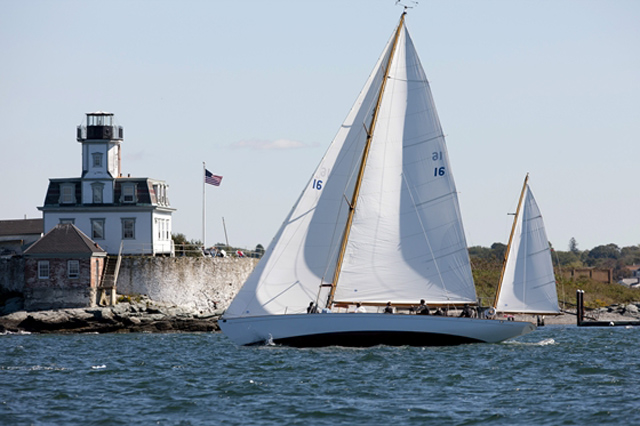Dorade Log No. 1: an iconic classic racer
Boats.com editor-in-chief John Burnham gets ready to help campaign an iconic racing yawl
“Are you on a diet yet?” asked the voice on the phone. “Dorade is a very small 52-footer, and she only has a 10-foot beam.” I shrugged off the comment, but it was the first of many that began to paint a new picture for me of one of the most famous ocean racers of all time — one which I have signed aboard to sail the 635-mile Newport-Bermuda Race in June.

The classic yawl Dorade, designed and first owned by Olin Stephens, sails close-hauled past Rose Island Light in Newport, Rhode Island - photo courtesy of Billy Black
The reality of racing a yawl-rigged wooden boat from the black-and-white era seemed distant until about a week ago, when I began to realise I might know more about sailing this 1929 design than I had expected. With 52 feet of overall length and 10-foot 3-inch beam, Dorade is lean, long, well-ballasted, and has low wetted surface. Which, except for the overall length, is much like the boats I’ve been racing for nearly 25 years.
“She’s an Eight-Metre,” my friend (and yachting historian) John Rousmaniere said, “just like your International One-Design is a Six-Metre. Dorade was built on City Island (N.Y.) at Minnefords,” he added, “the yard next door to Nevins, using Nevins' techniques, which became Olin’s trademark: Build them light and strong, of expensive woods like mahogany on oak frames; build light, strong masts, and sail them hard. The boat is fast upwind… you know Rod sailed her back from England in 1933 in just over 20 days, upwind all the way.”

Dorade's hull lines, viewed here in perspective, show a deep, narrow wineglass shape with long overhangs. Plans copyright by Sparkman and Stephens - used by permission
So I looked at the photos again, past the traditional rig and sturdy bulwarks, and saw more than a passing similarity to our IOD’s 1935 Six-Metre shape, which is also slim, long, has a wine-stem cross section, and is built of mahogany. It’s a shape, or more accurately, a style of hull, that I know pretty well and I could see why she drives to windward efficiently.
When I ran my observation past Bruce Johnson, chief designer of Sparkman & Stephens, he apologised for being a killjoy, then pointed out that the differences are dramatic. Dorade‘s forefoot isn’t cut away, her bilges are comparatively slack, and she is much narrower for her length, he explained. I did the maths on that last one, and of course he was right: The IOD has a waterline length to waterline beam ratio of about 3.3; Dorade's is north of four!
Still, I now have some expectations based on many years of sailing both IODs and Shields. Dorade will handle herself confidently in waves. She will be pretty wet on deck, and given her shape she will probably drag plenty of ocean along when close to hull speed. She’ll likely pitch some in light air and chop, but with her fine ends that will vary a lot depending on the wave period. Downwind, she’ll sail deep, in good old displacement mode, and although she’s reputed to roll, she’ll stay pointed where her helmsman aims her. If the waves are big, we’ll surf, but we’ll never be hanging off the transom on any kind of a plane.
I don’t expect to do much surfing in June on the Bermuda course, which more often presents reaching and upwind angles, but I’m looking forward to getting to know Dorade long before that in some very different conditions, sailing with owner Matt Brooks and much of our Bermuda crew at two spring Caribbean regattas. The first, the St Maarten Heineken Regatta, starts on March 1!
Whatever I may think I know now, I will soon learn much more. As I do, I look forward to reporting further on sailing Design No. 7, the 82-year-old lady who launched Sparkman & Stephens and changed the face of ocean racing.

The author's IOD, a 1935 design by Norway's Bjarne Aas, displays the graceful hullform of the era, but is beamier than Dorade, with a cutaway forefoot














